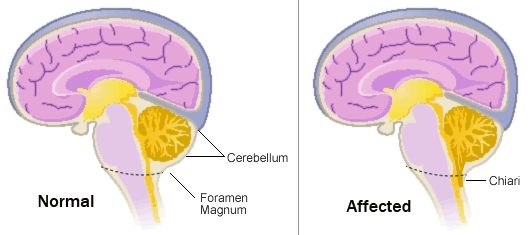Chiari malformation
We are nationwide leaders in Chiari malformation research and care. Our neurosurgeons use the latest technology to treat every patient and help them recover after surgery.
Dr. David Limbrick, the chair of the Department of Neurosurgery, is the number one NIH funded neurosurgeon in the country for Chiari malformation and has published over 40 papers on the condition.
Dr. Limbrick also offers virtual specialist review before your visit to VCU Health.
Start your virtual specialist review
Request a neurosurgery appointment
Request an appointment for your child
What is Chiari malformation?

In Chiari malformation, the lowest part of the brain — called the cerebellum — pushes into the spinal canal.
We treat all types of Chiari malformation:
- Chiari 1 is the most common type and can affect infants, children or adults.
- Chiari 2 is most often found in people with spina bifida.
- Chiari 3 is a more rare and severe type that is often seen with a developmental problem called encephalocele.
- Chiari 4 is a rare type that usually means the cerebellum is not fully developed.
- Other types include Chiari 0, Chiari 0.5, and Chiari 1.5.
The exact cause for Chiari malformation is not known. Our team is working hard to find answers and give every patient the best care.
What are the symptoms of Chiari malformation?
The most common symptoms of Chiari malformation are:
- Headaches, especially if they get worse with laughing, coughing or straining
- Back pain
- Neck pain
Chiari malformation can also cause other symptoms, including:
- Choking
- Dizziness or balance problems
- Hearing loss
- Numbness or other strange feelings in the arms or legs
- Ringing or buzzing in the ears
- Scoliosis or spinal deformity
- Sleep apnea or sleeping problems
- Trouble swallowing
- Trouble with hand-eye coordination and fine motor skills
- Weakness in the arms or legs
However, not all Chiari malformation patients have symptoms.
Conditions associated with Chiari malformation
Some conditions often associated with Chiari malformation are:
- Fluid in the spinal cord, also known as syrinx or syringomyelia.
- Abnormal growth of the facial bones or skull, such as craniosynostosis and other craniofacial conditions.
- Hydrocephalus
- Scoliosis or spinal deformity
While these are some of the most common associated conditions, Chiari malformation is seen alongside many other conditions, including:
- Blood flow conditions like venous sinus narrowing
- Conditions affecting connective tissues. This includes hypermobility conditions like Ehlers-Danlos syndrome.
- Dysautonomia and positional orthostatic tachycardia syndrome (POTS)
- Idiopathic intracranial hypertension, which causes increased pressure in the skull.
- Inflammatory conditions
- Leakage of brain and spinal fluid, also called cerebrospinal fluid leak.
- Spinal cord tethering
How is Chiari malformation treated?
Surgery to decompress the Chiari malformation and relieve pressure is one treatment option. Other care can include treating related issues, like spinal instability, spine fluid leakage or blood flow.
Our providers can also use MRI imaging and sleep studies to track a patient’s condition.

